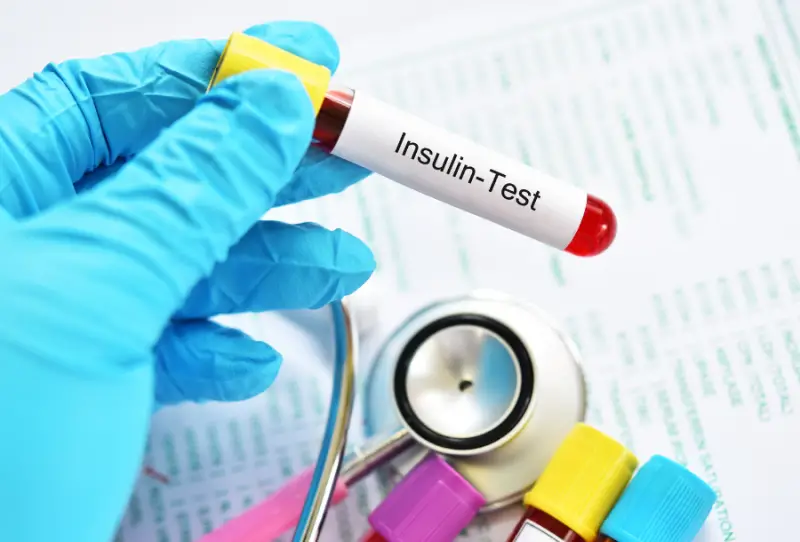Insulin is a crucial hormone produced by the pancreas that regulates how your body uses glucose for energy. When you eat, carbohydrates are broken down into glucose, which enters your bloodstream. In response, the pancreas releases insulin to help transport this glucose into your cells, where it’s used for energy or stored for later use. Without insulin, blood sugar levels would rise uncontrollably, leading to hyperglycemia and potential long-term complications.
In a healthy individual, insulin works efficiently to keep blood glucose levels within a stable range throughout the day. However, when your body becomes less responsive to insulin—a condition known as insulin resistance—the pancreas compensates by producing more insulin. Over time, this can lead to elevated fasting insulin levels and eventually to metabolic disorders such as prediabetes and type 2 diabetes. Understanding your insulin fasting levels gives you an early insight into your body’s metabolic health, even before blood sugar issues appear.
Insulin’s influence goes far beyond blood sugar control. It affects fat storage, protein synthesis, and even appetite regulation. When insulin levels remain consistently high, your body’s ability to burn fat decreases, potentially leading to weight gain, fatigue, and difficulty maintaining energy levels. Monitoring fasting insulin can therefore help you identify hidden imbalances before they progress into more serious health issues.
What Are Insulin Fasting Levels?

Fasting insulin levels measure the amount of insulin circulating in your blood after you’ve gone without food for at least eight hours. This test is often performed in the morning, before breakfast, to assess how your pancreas and body respond in a resting, non-fed state. The result helps determine whether your insulin levels are appropriate for your fasting blood glucose levels, giving an early indication of how efficiently your body processes glucose.
Unlike a fasting glucose test, which only measures sugar concentration, a fasting insulin test reveals how hard your pancreas is working to maintain that balance. For instance, a person may have normal blood sugar but elevated insulin, suggesting that their pancreas is overcompensating due to insulin resistance. This makes the fasting insulin test a valuable tool for early detection of metabolic dysfunction.
Doctors sometimes pair the fasting insulin test with the HOMA-IR (Homeostatic Model Assessment for Insulin Resistance) calculation, which estimates insulin resistance based on both fasting glucose and insulin levels. Together, these markers provide a clearer picture of your overall metabolic health and your risk for developing diabetes or related conditions.
Normal Ranges for Fasting Insulin Levels
While exact values can vary slightly between laboratories, the generally accepted normal range for fasting insulin levels in adults is 2 to 25 µIU/mL. However, most functional medicine experts suggest that optimal fasting insulin levels should ideally fall between 2 to 8 µIU/mL. Levels above 10 µIU/mL may indicate developing insulin resistance, even if blood glucose remains within normal limits.
Low fasting insulin levels, on the other hand, can point to pancreatic insufficiency or type 1 diabetes, where the pancreas is unable to produce enough insulin. The interpretation of these levels depends heavily on context—your blood glucose, body weight, and overall health status should all be considered together rather than in isolation.
For example, someone with a fasting insulin level of 15 µIU/mL but normal glucose might still be at risk of insulin resistance. Conversely, an individual with low insulin and high glucose could be developing type 1 or late-stage type 2 diabetes. That’s why physicians often evaluate both insulin and glucose together to get a complete understanding of metabolic efficiency.
Why Monitoring Insulin Fasting Levels Matters
Checking your fasting insulin levels is one of the most effective ways to assess early metabolic imbalance long before symptoms of diabetes appear. Many individuals maintain normal blood sugar levels for years while their insulin quietly rises, signaling that the body is working overtime to keep glucose under control. By identifying this pattern early, you can make lifestyle changes to improve insulin sensitivity and prevent disease progression.
Elevated fasting insulin levels are not only linked to diabetes risk but also to other chronic conditions. High insulin levels can promote fat storage, increase inflammation, and contribute to hypertension and cardiovascular disease. Furthermore, chronically elevated insulin can interfere with hormonal balance, affecting fertility, energy, and mood stability.
Monitoring fasting insulin provides a proactive approach to health management. It allows individuals to take control through diet, exercise, and lifestyle adjustments that support better insulin sensitivity. Since fasting insulin can change in response to your habits, rechecking it periodically offers valuable feedback on how your interventions are working.
How to Check Your Insulin Fasting Levels
Preparing for the Test
Before testing, you’ll need to fast for at least eight to twelve hours. This means avoiding all food and caloric beverages, though water is allowed. The goal is to measure your baseline insulin level without interference from recent meals. Testing is usually done in the morning to ensure consistent results.
Certain factors can affect your fasting insulin levels, including stress, poor sleep, and recent physical activity. To get the most accurate reading, try to rest well the night before, avoid vigorous exercise, and limit caffeine. If you’re taking medications that influence glucose or insulin, consult your doctor beforehand to determine if adjustments are necessary before testing.
When you arrive at the clinic, a healthcare professional will draw a small blood sample from your vein. The sample is then analyzed in a lab to determine the amount of insulin present in your bloodstream. Results are typically available within a few days, depending on the laboratory.
At-Home Testing Options
Recent advancements have made it possible to measure fasting insulin at home using mail-in blood tests. These kits allow you to collect a small blood sample via a finger prick and send it to a certified laboratory for analysis. The convenience of at-home testing is appealing for those who wish to monitor their insulin and glucose levels regularly without frequent clinic visits.
While home tests are convenient, they may not always provide as detailed an analysis as a lab-based test ordered by your doctor. However, when used as part of a broader health monitoring plan, they can still provide valuable insights into your metabolic trends over time. Always review your results with a qualified healthcare professional to interpret them correctly.
Factors That Affect Fasting Insulin Levels
Several lifestyle and biological factors can influence fasting insulin levels. Diet plays one of the most significant roles, as high-carbohydrate or high-sugar diets often drive up insulin production. Consuming refined carbohydrates and sugary beverages frequently causes repeated insulin spikes, which can eventually lead to resistance and higher fasting levels.
Physical inactivity is another major contributor. When muscles are not regularly engaged through exercise, they become less sensitive to insulin’s effects, forcing the pancreas to release more insulin to achieve the same glucose-lowering response. Regular physical activity enhances insulin sensitivity by helping muscles use glucose more efficiently.
Other factors include stress and poor sleep. Chronic stress leads to elevated cortisol levels, which in turn increase insulin secretion and blood glucose. Similarly, inadequate sleep disrupts hormonal balance, impairing insulin sensitivity. Genetics, body weight, and even age can also influence your baseline insulin levels, making individualized assessment important for accurate interpretation.
The Link Between Fasting Insulin and Insulin Resistance
What Is Insulin Resistance?
Insulin resistance occurs when your body’s cells no longer respond effectively to insulin, forcing the pancreas to produce more of it to maintain normal blood sugar levels. Over time, this creates a cycle of elevated insulin and glucose that can lead to prediabetes and eventually type 2 diabetes. Insulin resistance often develops silently and can persist for years without obvious symptoms.
Early Warning Signs
Although insulin resistance can be difficult to detect without testing, some early signs include fatigue after meals, cravings for sweets, weight gain around the abdomen, and difficulty losing weight despite effort. Skin changes such as darkened patches on the neck or armpits, known as acanthosis nigricans, can also signal elevated insulin levels.
Testing for Insulin Resistance
The fasting insulin test, when paired with fasting glucose, allows for calculation of the HOMA-IR index. This value helps determine how resistant your body is to insulin. A HOMA-IR value above 2.0 is often considered a sign of reduced insulin sensitivity. Tracking this number over time can show whether lifestyle changes are effectively improving metabolic function.
How to Lower High Fasting Insulin Levels
Improving insulin sensitivity and lowering fasting insulin requires a combination of dietary, lifestyle, and sometimes medical interventions. Reducing your intake of refined carbohydrates and added sugars is a key first step. Instead, focus on whole, nutrient-dense foods like vegetables, lean proteins, and healthy fats that provide steady energy without spiking insulin.
Regular physical activity is equally important. Aerobic exercises such as brisk walking, cycling, or swimming help muscles absorb glucose more effectively, reducing the need for high insulin output. Resistance training further enhances muscle sensitivity to insulin, amplifying these benefits. Aim for consistent exercise at least five days a week for lasting results.
Managing stress through mindfulness, yoga, or deep breathing exercises also supports better insulin regulation. Chronic stress hormones like cortisol directly increase insulin levels, so relaxation techniques can have a measurable impact. Prioritizing sleep and maintaining a consistent schedule help regulate hormonal rhythms that influence metabolism. In some cases, doctors may recommend medications like metformin for those with significantly elevated insulin or insulin resistance.
When to See a Doctor
If your fasting insulin levels are consistently high or if you experience symptoms such as persistent fatigue, unexplained weight gain, or increased hunger, it’s important to consult a healthcare provider. Elevated fasting insulin is not a diagnosis by itself but rather a signal that your metabolism may not be functioning optimally. Early medical guidance can help you create a personalized plan for improving your health.
For individuals already diagnosed with diabetes, tracking fasting insulin alongside glucose can help fine-tune treatment strategies. Your doctor may also test additional markers such as HbA1c, triglycerides, and cholesterol to evaluate overall metabolic health. The goal is to catch imbalances early, before they lead to more serious complications.
Long-Term Benefits of Managing Fasting Insulin
Maintaining normal fasting insulin levels brings long-lasting benefits beyond preventing diabetes. It supports stable energy levels, better mental focus, and improved fat metabolism. People with balanced insulin often find it easier to maintain a healthy weight and reduce cravings for sugary foods. Proper insulin control also reduces inflammation, which plays a role in heart disease and aging.
Over time, lifestyle choices that promote insulin balance can profoundly affect your overall health. Regular exercise, balanced nutrition, stress management, and adequate sleep work synergistically to keep insulin in check. Monitoring fasting insulin periodically can serve as a powerful motivator, showing tangible progress as your body becomes more metabolically efficient.
FAQs about Insulin Fasting Levels
What is the ideal fasting insulin level for optimal health?
The ideal fasting insulin level typically ranges between 2 to 8 µIU/mL, which indicates efficient glucose metabolism and good insulin sensitivity. Levels above 10 µIU/mL may suggest early insulin resistance.
Can you have normal blood sugar but high fasting insulin?
Yes. Many people maintain normal glucose levels while their insulin levels rise to compensate for decreased sensitivity. This is a warning sign of insulin resistance and should be addressed early.
How often should I test my fasting insulin levels?
If you’re monitoring your metabolic health or have a family history of diabetes, testing once or twice a year is often sufficient. However, if your levels are abnormal, your doctor may recommend more frequent testing.
Does fasting insulin affect weight loss?
Absolutely. Elevated insulin levels make it harder for your body to burn stored fat, leading to slower weight loss. Improving insulin sensitivity helps unlock fat-burning potential and supports sustainable results.
Can diet alone lower fasting insulin?
In many cases, yes. Reducing refined carbs, avoiding sugary drinks, and eating more whole foods rich in fiber and healthy fats can significantly lower insulin levels over time.
Conclusion
Understanding and monitoring your insulin fasting levels offers one of the most accurate ways to gauge your metabolic health. Even when blood glucose appears normal, fasting insulin can reveal hidden imbalances that precede diabetes and other chronic diseases. By learning what is normal and how to check it, you empower yourself to take proactive control of your well-being.
Through balanced nutrition, regular exercise, adequate rest, and mindful stress management, you can optimize your insulin response and maintain long-term health. Regular testing provides valuable feedback to help guide your choices and prevent metabolic decline. In essence, keeping your fasting insulin within the normal range is not just about avoiding disease—it’s about ensuring your body functions at its best every day.
Disclaimer: This article is for informational purposes only and is not a substitute for professional medical advice. Always consult your doctor regarding insulin or any health concerns.



